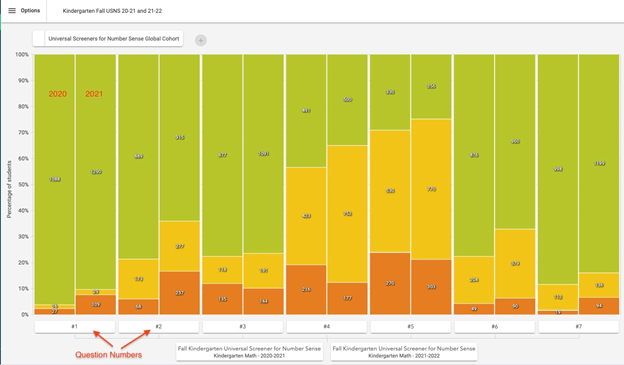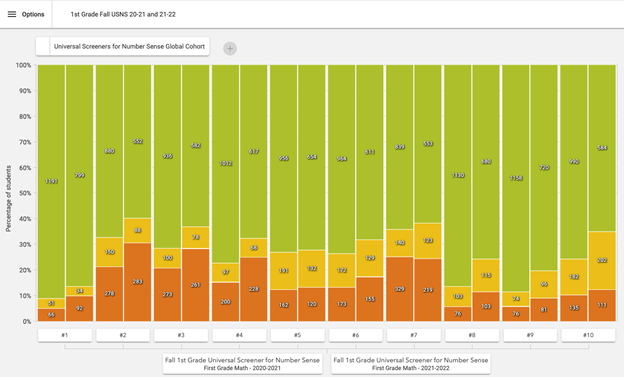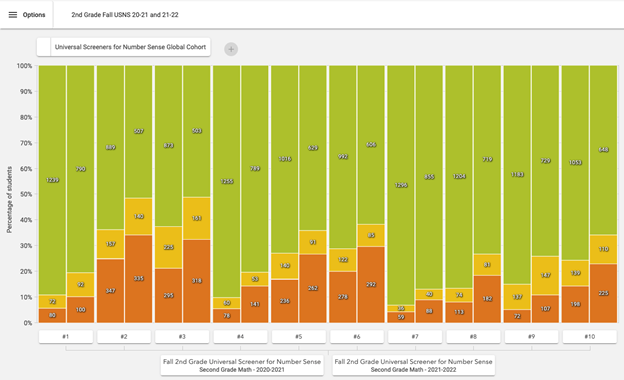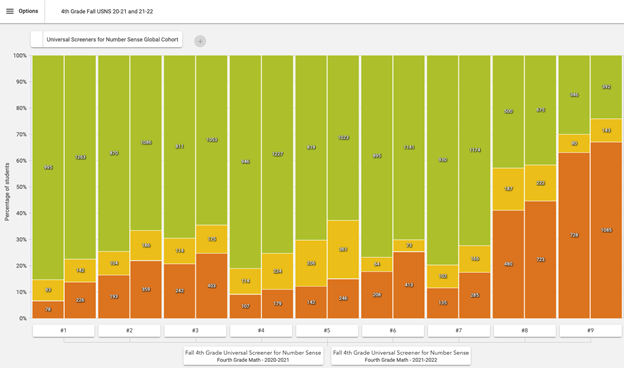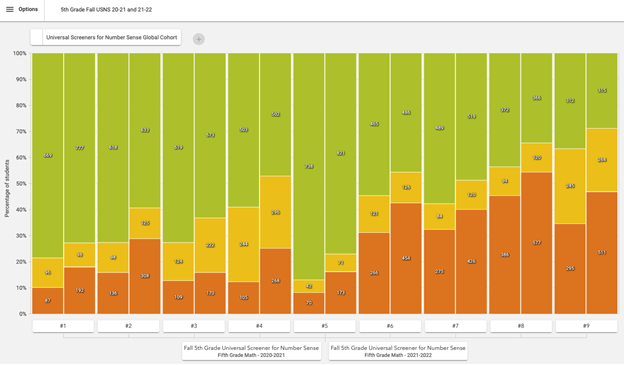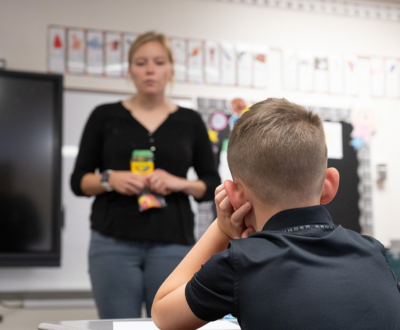A Reflection on USNS Results after 18 months of Covid-19 Pandemic
The elementary math screener Universal Screeners for Number Sense (USNS)’s fall results reflect the struggles that our schools and our students have experienced during this pandemic. Although others attempt to measure the performance of students on assessments in terms of months, the USNS assessments focus on specific high-leverage skills and concepts. These results reveal some specific trends amid a largely troubling picture.
The consistent trend across the results for all grade levels is that students did not perform as well as they did in the fall of 2020. This appears to be true of each and every question on the assessment from kindergarten to fifth grade. What this says first and foremost is that in-person schooling works, and is important. The fundamental skills and concepts assessed in the USNS are not simply acquired over time, they are learned in classrooms with teachers and peers.
It is important to state that the results below are from Forefront and that this raw data that comes from a wide variety of districts. There are more districts participating in 2021 than 2020. For this reason, the overlap of the schools contributing to this information is not 100%. It should also be noted that some Forefront teachers only assess and enter data for students who have been pre-selected. That is to say, although these data are an approximation of the general population, each year there is a concentration of results from students who have already been identified as struggling.
Kindergarten USNS Results
The report above, created in Forefront, shows the Global results of the Fall USNS assessments, question by question. Two stacked bars are above each question number. In each pair, the bar on the left represents the results from fall of 2020, and the bar on the right those from fall of 2021. For Forefront clients, explore how to create this report here.
Overall, the percent of students performing in the proficient range has decreased. Percentage wise, the largest drop we see in this year’s results is question #2: Numeral ID, which assesses the ability to read the numbers 1-10. This is a critical skill needed to access instructional materials and instruction. Teachers should be aware that this skill, which always needs attention, might need additional focus this fall.
A highlight here are the results of questions #3, #4, and #5. This is a series of questions:
- Question #3 has the teacher present 7 counters on a plate and ask, “How many are there?”
- For #4 the teacher simply rotates the plate and asks again, “How many are there?”
- Question #5 asks the teacher to confirm that there are 7. Then s/he should place 3 more counters with the others, asking “How many are there now?”
For these three questions, the yellow / basic increased on questions 4 and 5. This indicates that more students are recounting to find out how many, but still arriving at the correct answers. For this reason, the percentage of students answering correctly actually improved. However, the mental “just knowing” and confidence is missing. In fact, students are still counting sets of objects quite well.
First Grade USNS Results
Looking at these first grade results the percentage of students proficient, question by question, has dropped. As in kindergarten, the biggest drop in overall proficiency is the area of Numeral ID. Teachers should be aware that students will need additional opportunities to read numbers aloud. This is especially true for those who are developing their proficiency with the language of instruction.
The question where the results have changed the least from 2020 to 2021 is #5, “How many counters are here?” (15). One to one correspondence, is a foundational skill/concept and long considered a developmental milestone. It is interesting to note that rote counting (#1) took a bigger hit than 1:1 correspondence did.
Second Grade USNS Results
First of all, the percentage of students performing “in the green” in 2021 is less than it was in 2020. Percentage-wise the worst news is for question #4 – Numeral ID, which was also true in kindergarten and first grade.
Teachers should spend time with each and every student to assess and teach this skill as necessary. Reading numbers to 100 in second grade is not optional. Every student must be able to fluently read numbers to 100 at the beginning of 2nd grade. Parents are often very willing and able to support this effort. One idea is to have the students who would benefit write the numbers 1-100 on cards. Check and correct student work for accuracy. Then, share these cards with family to have them practice reading them at home.
The other questions that I will highlight are questions #1, #2, and #5. These three questions have been demonstrated to be highly predictive of state math assessment results in 3rd, 4th, and 5th grades. Students should be provided with bountiful opportunities to practice and use the skills/concepts assessed by these questions: rote counting, verbal counting, and adding across 10 in the context of materials.
Third Grade USNS Results
Results as of October 20, 2021, show a 3.36% drop in the number of students performing in the proficient range for Question #9. “What are two numbers that add together to make 13?” This is good news; however, the jump in the percentage of students who performed at level 1 went up by 70%. In other words, the number of students who quickly can identify two numbers that add to 13 did not significantly decrease, but a larger group of students were unable to find two numbers that add to 13 even when given time to think about it.
Conversely, for question #7, “What is 50-24?” the level 3 / proficient results appear to have fared the worst during this pandemic. Question 7 is the question that, year after year of this project, has consistently had the lowest levels of performance. It is interesting that more students were able to solve the problem on their second attempt. Perhaps with ample opportunities to work with mental subtraction students will quickly rebound.
Other notable drops in proficiency: the verbal forward number sequence (question #1) and numeral identification (question #3) tasks. Instructional routines with daily opportunities for students to engage in counting, reading numerals, and solving mental math problems (number talks and number strings) appear to be especially important this year.
Fourth Grade USNS Results
In fourth grade, performance across every question in fall 2021 was not as strong as it was in 2020. Focusing on individual tasks, the largest jump in the percent of students performing at Level 1: Below Basic, is on question #6. The task is, “I have 82 pencils, and I want to put them into boxes with 10 pencils each. How many boxes can I fill?”
The question where the proficient range saw the smallest change from 2020 to 2021 is problem #8: 400 – 198. However, you might notice that there is a jump on this question in the number of students performing in the Level 1 range, meaning that more students were completely unable to solve this problem. Once again, this calls out for number talks and number strings as instructional routines.
Fifth Grade USNS Results
In fifth grade, there is a drop in the percentage of students performing at the proficient level across all questions. Unfortunately, across the 9 questions there was an average drop of 8.6% in the percentage of students performing in the proficient range. This is the highest average drop in the K-5 series.
The most striking jumps in Level 1: Below Basic performance were on question #2 (Numeral ID) and question #4 (32 ÷ 4). Across all grades, students ability to successfully ID numbers was greatly impacted, taking the hardest hits in kindergarten, 1st, 2nd, and 5th grades. For the division problem, the problem is presented in the context of an array. Students thus need to be able to solve this problem and see how it relates to making equal groups. Division has been shown to be a significant predictor of later math performance. Teachers should target this skill/concept repeatedly throughout the year and provide just-in-time supports for students as division comes up in the instructional materials.
For the smallest drop in proficiency, we find that students performed roughly the same with question #1, “Count back starting from 1002.” (Stop at 997). Perhaps this was a skill that was already mastered by many students before the pandemic?
For fifth grade teachers, one area of focus is to ensure that students can read numerals. Students need many opportunities to read numbers out loud for teachers and for peers. As necessary, instruction should be provided. Additionally, instructional routines that focus on division and subtraction (including with money) are important. Issues related to fractions and decimals (question #9) existed long before the pandemic. Continuing to refine, and improve how we support students in developing understandings of fractions is an ongoing challenge for 3rd – 5th grade teachers.
Conclusion
The impacts of the pandemic are visible in the Fall 2021 K-5 Universal Screeners for Number Sense results across all questions and all grade levels. This highlights the importance of consistent in-person experiences for students.
The category of questions where the greatest impact was measured was in the area of numeral reading. This skill is inherently social. It involves the verbalization of the reading of numerals. Teachers should be aware of the need to focus on this skill as they approach instruction this fall. They can provide students with ample opportunities for students to read numerals and targeted instruction for those who would benefit.
While these results are somewhat alarming, they also reveal the significant impact that teachers make on these core number sense skills and concepts. By focusing on these concepts and skills this fall, teachers will set students up for success in their mathematical development.
Provide your students this fall with ample opportunities to practice their verbal counting, numeral reading, and mental math. For those students who showed patterns of issues with the core skills and concepts assessed with the USNS, provide additional opportunities to learn and practice. To ensure that progress is being made, teachers should regularly check to see that the students are making progress. Ensuring that all students are provided with opportunities to develop these critical skills and concepts will help to ensure access to grade level instruction and curricular materials.
About the author:
David Woodward is an educator with more than 25 years of experience in education as a classroom teacher, a district leader in math education, and a frequent presenter at conferences nationally. He founded Forefront Education to help educators better understand student learning with classroom assessments and support standards-based grading that is automatic, accurate, and reliable. David recently retired as a math coach at Boulder Valley School District in Colorado in June 2020. He is the leader of the Universal Screeners for Number Sense project (formerly known as the BVSD k-5 Math Screeners) a series of open-source assessments. Read more.
About us and this blog
Our team and tools help schools implement standards-based grading, streamline assessment systems, and use meaningful data to drive decision-making.
Webinar: USNS Fall Results
Watch our discussion of the fall USNS results presented on November 10, 2021, at 12 PM EST. Gain highlights of the 2021 USNS results and guidance on how to understand your own students' learning.
More from our blog
See all postsForefront is the only assessment data solution optimized for classroom assessment results, leveraging these results to fuel instruction, PLCs, and grading. Elevate meaningful assessment data district-wide to transform how you understand and communicate about student learning across your schools.
Copyright © 2025 Forefront Education, Inc. All Rights Reserved.



